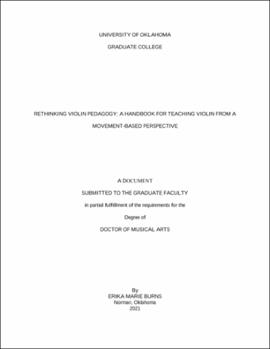| dc.description.abstract | Violinists regularly experience musculoskeletal pain and tension while playing their instrument. Many view this as an occupational hazard, a byproduct of long days of playing. However, preventative and rehabilitative care like stretching, massages, and painkillers only go so far when the root of the problem lies in the violinist’s misuse of their body while playing. It is essential that violin teachers not only provide their students with biomechanically sound foundations of technique, but to prioritize retraining movement and motor skills to fix longstanding problems with playing. However, many violinists begin their teaching careers without a formal understanding of biomechanically healthy technique or effective teaching strategies. This document proposes using the framework of Qualitative Movement Diagnosis (QMD) to empower violinists to better teach and evaluate technique from a kinesiological, or movement-based perspective. QMD is a tool developed by academic researchers for diagnosing and correcting movement errors. As a multidisciplinary approach drawing from kinesiology, exercise pedagogy, psychology, and physiology, QMD is uniquely adaptable to movement-based disciplines and therefore can easily extend to violin teaching. This study incorporates existing music-pedagogy research and important violin treatises within the framework of QMD in the form of an introductory handbook comprising theoretical concepts, suggestions, and techniques drawn from kinesiology, sports, and dance-imagery research to help instructors assess and supplement their own gaps in knowledge; prioritize biomechanically healthy movement; better observe, evaluate, and diagnose technique issues; and provide tailored remediation and other interventions.
Keywords: violin, teaching, pedagogy, injury, movement, remediation, kinesiology, dance imagery, Qualitative Movement Diagnosis, Franklin Method | en_US |

